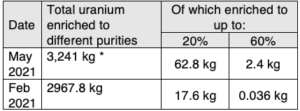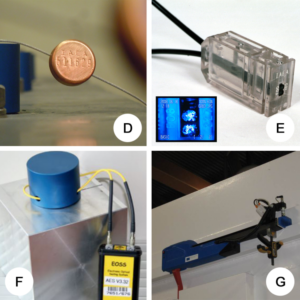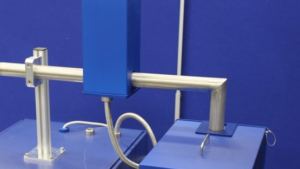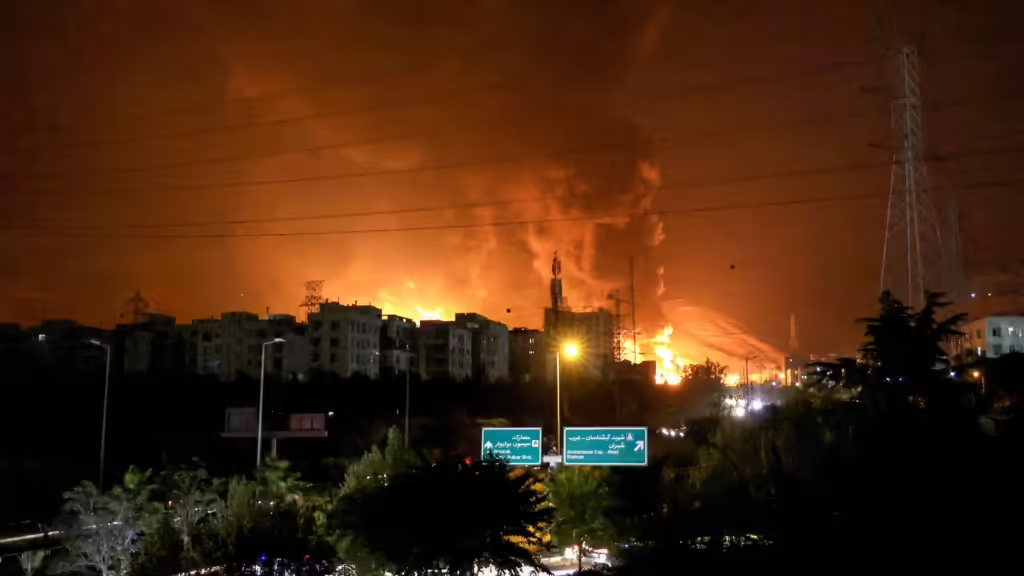FRESH AIR
Increasing IAEA warnings about Iran
June 8, 2021 | Ran Porat and Oved Lobel

The latest reports on Iran by the International Atomic Energy Agency (IAEA), which have not been made public but were circulated among member states on June 1, reveal that Iran continues to enrich uranium close to levels needed for an atomic bomb. Teheran has now accumulated enough fissile material for at least three nuclear warheads, with a potential breakout time of fewer than 3 months.
Meanwhile, the IAEA’s Director General Rafael Grossi has been making statements in recent weeks which sound increasingly alarmed over Iran’s activities and the IAEA’s own lack of ability to effectively monitor Iranian progress.
This backgrounder details the latest IAEA findings and warnings about Iran.
Iran’s fissile material stockpiles according to IAEA estimates

* Lacking full access to the Iranian nuclear activities, the May IAEA data are estimates only.
Analysis:
- At current production capacity, Iran needs a year to enrich enough uranium of 60% purity to military-grade levels (90%) for one bomb.
- Iran’s worst-case scenario breakout time, however, is only 2.3 months
Breakout time is the period required for a state to achieve nuclear weapons capabilities for one nuclear weapon unless it is stopped by either diplomatic or military steps. It takes into account production capabilities as well as current production levels. - Iran now has enough low enriched uranium to convert to three atomic warheads if enriched to the required 90% levels. Theoretically, this could be achieved within 7 months.
- The increase in stockpiles is the lowest since Feb 2020, possibly as the result of the explosion at Iran’s main enrichment facility at Natanz in April, which reportedly decreased the number of operational cascades of uranium enrichment centrifuges to 20, down from 35-37 beforehand.
- Iran significantly increased and improved the production of uranium metal (only usable for the core of a nuclear warhead) and has amassed 2.42 kg of it.

- The fissile material stockpile is 16 times more than allowed in the 2015 nuclear deal (JCPOA), which is currently now being renegotiated in Vienna. At the same time, it is much lower than the 6-10 tonnes Teheran amassed in 2015.
IAEA Monitoring
IAEA reports say Iran has dramatically limited IAEA monitoring of its nuclear activities since Feb. 15, and is threatening to erase the recordings from the agency’s monitoring equipment installed in Iranian facilities.

IAEA inspectors measurement tools used, for example, to record radiation levels, take pictures and record audio, measure distances and more (source: IAEA)
The latest report reveals Teheran has also blocked IAEA access to:
- Data from online enrichment monitors, cameras, recordings of measurements and electronic seals at Natanz and Fordow. The online monitors normally provide 24/7 measurements of enrichment levels, while the seals are meant to assure equipment and materials remain unused and/or unaltered by Iran without IAEA knowledge.
- Daily visits by IAEA inspectors to enrichment facilities and to other sites.

Different types of seals used by the IAEA, including the electronic seal (image F). The seals are meant to assure equipment and materials remain unused and/or untouched (source: IAEA)
In addition, Iran has stopped delivering updated inventory reports and declarations on the production of centrifuge parts and reportedly told the IAEA that it is no longer sees itself obligated to report the construction of new nuclear facilities (Modified Code 3.1) while at the same time claiming it does not plan to build such facilities in the near future.

An IAEA online enrichment monitor – which verifies enrichment levels 24/7 (source: IAEA)
IAEA findings regarding Iran’s past unexplained nuclear activities
Iran again failed to present acceptable explanations for traces of man-produced uranium found at alleged nuclear sites which were never disclosed to the IAEA as required by Teheran’s international obligations under the Nuclear Non-Proliferation Treaty (NPT).
The possible sites in question are the following:
- Turquz-Abad warehouse, Teheran – where undeclared nuclear material and equipment were allegedly hidden.
- Lavisan-Shian – where Iran allegedly produced uranium deuteride for a neutron initiator, a key material for the chain reaction in the atomic warhead.
- Pilot uranium conversion facility, Teheran.
- Abadeh, part of the Marivan program – where Iran tested highly explosive components required for a nuclear warhead.
Grossi’s Warnings
As noted above, Director General Rafael Grossi has been making statements in recent weeks which sound increasingly alarmed over Iran’s activities and the IAEA’s reduced ability to effectively monitor them.
He told the Financial Times on May 26, “A country enriching at 60 per cent is a very serious thing — only countries making bombs are reaching this level. Sixty per cent is almost weapons grade, commercial enrichment is 2, 3 [per cent].”
He also warned that Iran was providing no answers to IAEA questions about uranium traces found at the nuclear sites never declared by Iran, but identified partly through Israel’s seizure of the Iranian nuclear archives in 2018:
“We found traces of uranium that has been subject to industrial processing in different places, which had not been declared by Iran. That is a big problem,” Grossi said on May 26.
He added, “We know that something happened here. There is no way round it. We have found this. There was material here. When was this? What has happened with this equipment? Where is the material. They have to answer.”
Grossi also emphasised that a straight return to the 2015 nuclear deal, or JCPOA “is not possible,” despite the negotiations in Vienna, because of the increasing technical sophistication of the Iranian program. “You cannot put the genie back into the bottle — once you know how to do stuff, you know, and the only way to check this is through verification. The Iranian programme has grown, become more sophisticated so the linear return to 2015 is no longer possible… Iran has accumulated knowledge, has accumulated centrifuges and has accumulated material.”
Finally, even while denying that the current lack of access to monitoring had left his inspectors flying blind, Grossi also admitted current interim arrangements reached after Iran limited monitoring in February – arrangements extended for another month on May 24 – were “not ideal” and only an “emergency device” to allow some monitoring to continue.
“If levels of access are restored, we can reconstruct what is happening,” Grossi said. “It is not ideal. It is an emergency device in order for us to continue having these monitoring activities.”
Worse, the head of the Atomic Energy Organization of Iran (AEOI) Ali Akbar Salehi reportedly sent a letter to Grossi claiming that the temporary deal allowing the IAEA to monitor Iranian nuclear activities had expired, despite Grossi’s announcement on May 24 that it had been extended for a month.
On June 7, Grossi informed the IAEA board of governors, “Iran has provided no new information in relation to one location; has not answered any of the Agency’s questions nor provided any information in relations to two other locations; and provided a written statement on a fourth location without any substantiating documentation.” Iran’s complete refusal to cooperate “seriously affects the ability of the Agency to provide assurance of the peaceful nature of Iran’s nuclear programme,” Grossi concluded.
Grossi and the IAEA are making it clear that Iran is enriching uranium to a degree only useful for nuclear weapons, accumulating new capabilities rapidly, and stonewalling IAEA inspectors by obstructing routine monitoring as well as refusing to answer questions about the IAEA’s discovery of material that suggests Iran has been lying to the agency all along. Given these warnings from this normally very careful, cautious agency, the world has every reason to be very worried.
Dr. Ran Porat is an AIJAC Research Associate. He is also a Research Associate at the Australian Centre for Jewish Civilisation at Monash University, a Research Fellow at the International Institute for Counter-Terrorism at the Interdisciplinary Centre in Herzliya and a Research Associate at the Future Directions International Research Institute, Western Australia.
RELATED ARTICLES

‘Optimism’ for Hamas to ‘exile’ their power and create a permanent ceasefire with Israel: Joel Burnie on Sky News

Australian government’s response to Iran-Israel conflict ‘disappointing’: Paul Rubenstein on Sky News

UNRWA feeds the ‘Palestinian delusion’ of no Jewish state: Dr Einat Wilf on Sky News




















